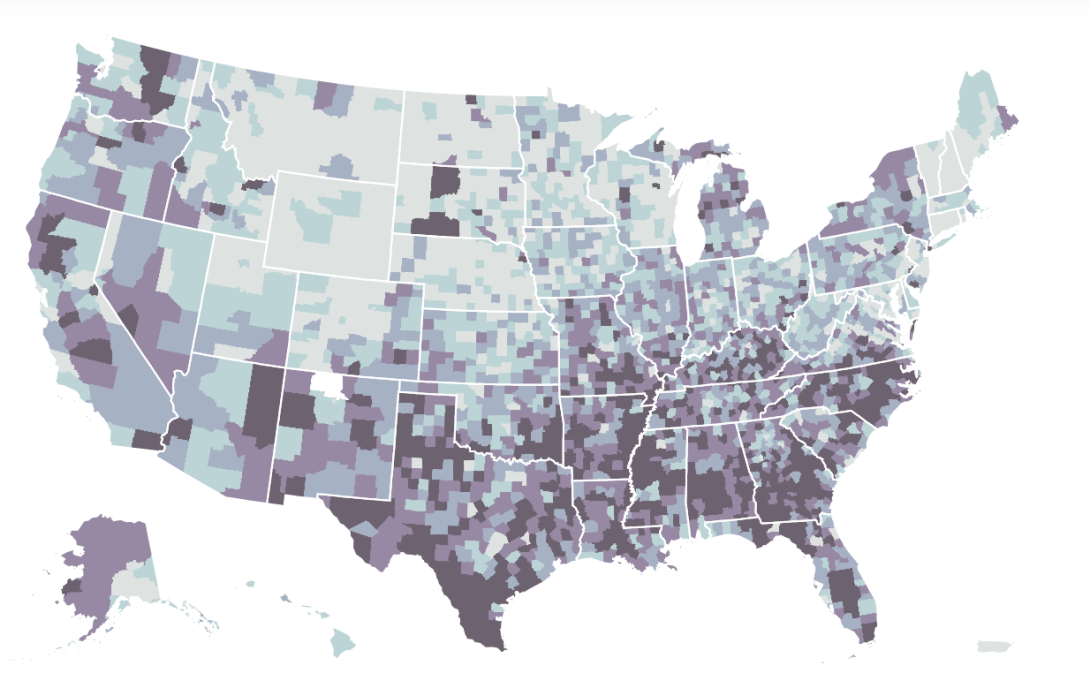COVID-19 looms over Southern states already walloped by poor health

The 10 counties most vulnerable for COVID-19 are in the South, according to the Surgo Foundation, a research group. These counties may need the most support if the new coronavirus spreads within their communities. The research group created the vulnerability index map above using several indicators, including socioeconomic status and factors related to the health care system. Communities with very high vulnerability are shown in the darkest shade. Read more here. (Map courtesy of the Surgo Foundation.)
Like warning lights on a dashboard: that's how time and time again large parts of the South* appear on maps showing death rates from many of the country's top killers. One map shows heart disease, the nation's leading cause of death, slamming large parts of the South. Another shows diabetes deaths burdening Southern states at the highest rates. Map after map delivers the same message: Large swaths of the South are disproportionately afflicted by several chronic illnesses.
Enter COVID-19. The Atlanta-based Centers for Disease Control and Prevention (CDC) has published a list of potential risk factors for severe illness from the disease. Nearly all are underlying medical problems. Several, like diabetes and chronic lung disease, already severely impact large parts of the South.
Diabetes, which affects around 34 million people nationwide, has been most prevalent across parts of the Deep South and Appalachia. Chronic obstructive pulmonary disease (COPD), which makes breathing difficult, impacts some 16 million people across the country and has been most prevalent in several Southern states. In the chart above, COPD is part of the chronic lung disease category.
New research also shows that smoking significantly worsens COVID-19, and the states with the largest shares of adult cigarette users are in the South, according to the CDC. While 16 percent of the U.S. population smokes, that figure jumps to 21 percent in Louisiana, Mississippi and Tennessee; 23 percent in Arkansas and Kentucky; and 25 percent in West Virginia.
Health policy researchers worry that the high prevalence of several chronic health conditions across the South make the region's residents especially vulnerable to severe COVID-19 illness.
'A perfect storm'
For years, health policy researchers have documented the South's frail health. "Southerners as a group are generally more likely than those in the rest of the nation to have certain chronic illnesses and to experience worse health outcomes," said a 2016 Kaiser Family Foundation (KFF) report.
Fast-forward to April 2020, when KFF published a COVID-19 vulnerability map taking into account the CDC's list of potential risk factors. It shows Southerners under 65 are especially vulnerable to serious illness from the new coronavirus because of underlying health conditions.
Other researchers have come up with similar findings. An analysis by the Surgo Foundation, an international research group, looked at multiple indicators including socioeconomic status and epidemiological and health care factors to identify the places especially vulnerable to the pandemic. It found that the 10 most vulnerable counties for COVID-19 are in the South.
"There are communities or populations that have underlying health risks, and the South is definitely one compared to other regions," Lisa Dubay, a senior fellow at the Urban Institute's Health Policy Center, told Facing South. She noted that most states that have not expanded Medicaid, the public health care program for low-income people, are in the South. "I think that sets up a perfect storm," Dubay said. "The South is not set up to make it easier for people to get care, particularly low-income populations that may actually be on the front lines."
In addition, COVID-19 could widen already-existing racial disparities in the South, according to Samantha Artiga, who heads KFF's Disparities Policy Project. "Disparities in the South also have important implications for racial and ethnic disparities, particularly since Black individuals make up a greater share of the population in the South compared to other regions," she said.
Already across the South, preliminary state data shows black Americans are dying of COVID-19 in disproportionate numbers. An outbreak in the region could place vulnerable communities at risk of severe COVID-19 illness and widen these already-existing racial disparities in COVID-19 deaths.
So what now?
It all depends on disease transmission, said Michael Kramer, social epidemiologist and associate professor at Atlanta-based Emory University.
"For instance, we saw the large outbreak in southwest Georgia that started from a large gathering, a funeral presumably. Once established, it spread quickly," he told Facing South. "Whether or when other communities, particularly communities of color, experience excess burden depends on when or if the disease is introduced into those communities."
In nearly all of the South, the number of new cases of COVID-19 is either flat or increasing, according to The New York Times. Some states with a recent increase in newly reported cases have recently expanded testing capacity, the newspaper reports.
The recorded death toll from COVID-19 in the U.S. has surpassed 100,000. As of June 1, the Northeast is the region where the virus has taken the greatest toll, and the Southern states with the highest rates of death per 100,000 people from COVID-19 are Louisiana at 60, Mississippi at 25, and Georgia at 19. Black residents in these states have been overrepresented in COVID-19 death tolls relative to their share of the state population.
Artiga at KFF sees a bright spot amid the pandemic: It has increased awareness and understanding of geographic disparities and their implications. Acknowledging these disparities, she said, is "one key step forward in addressing them."
* Facing South defines the region as including Alabama, Arkansas, Florida, Georgia, Kentucky, Louisiana, Mississippi, North Carolina, South Carolina, Tennessee, Texas, Virginia, and West Virginia.
Tags
Rolando Zenteno
Rolando Zenteno is the inaugural recipient of the Julian Bond Fellowship with Facing South.
